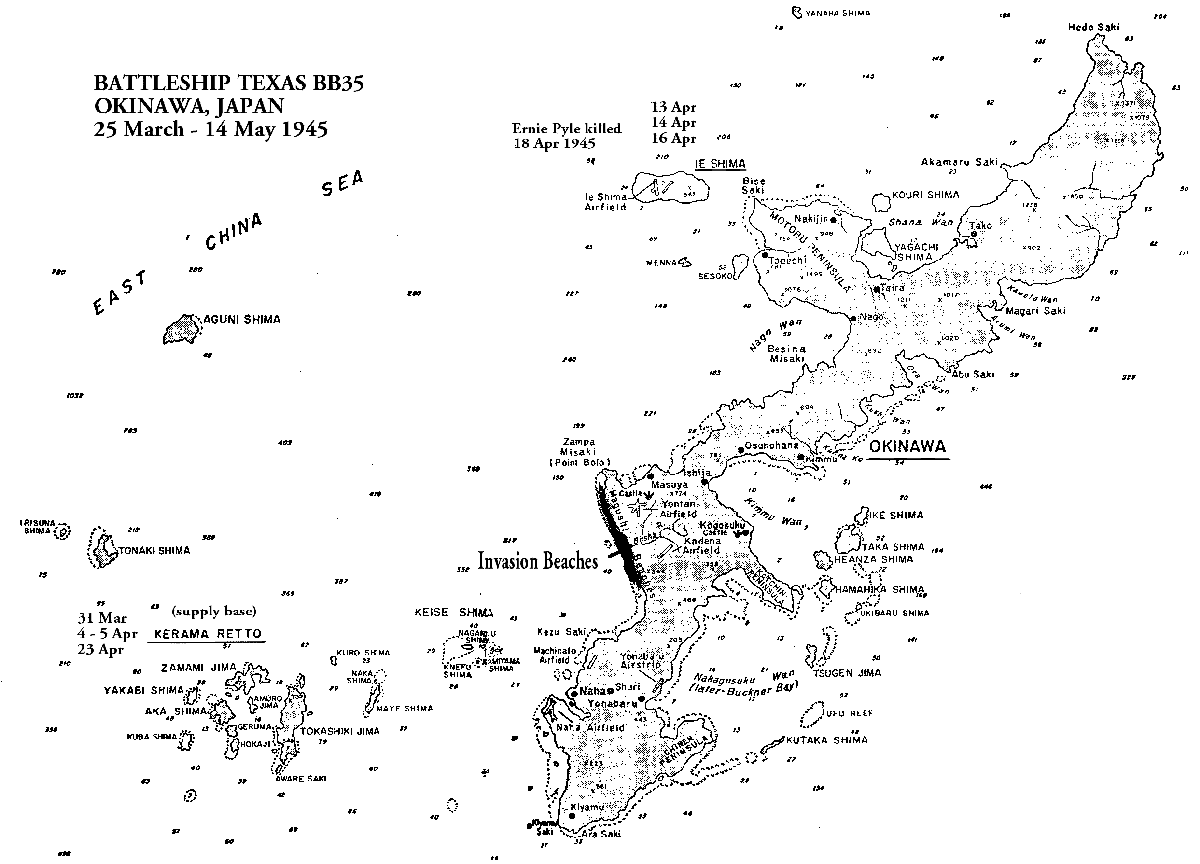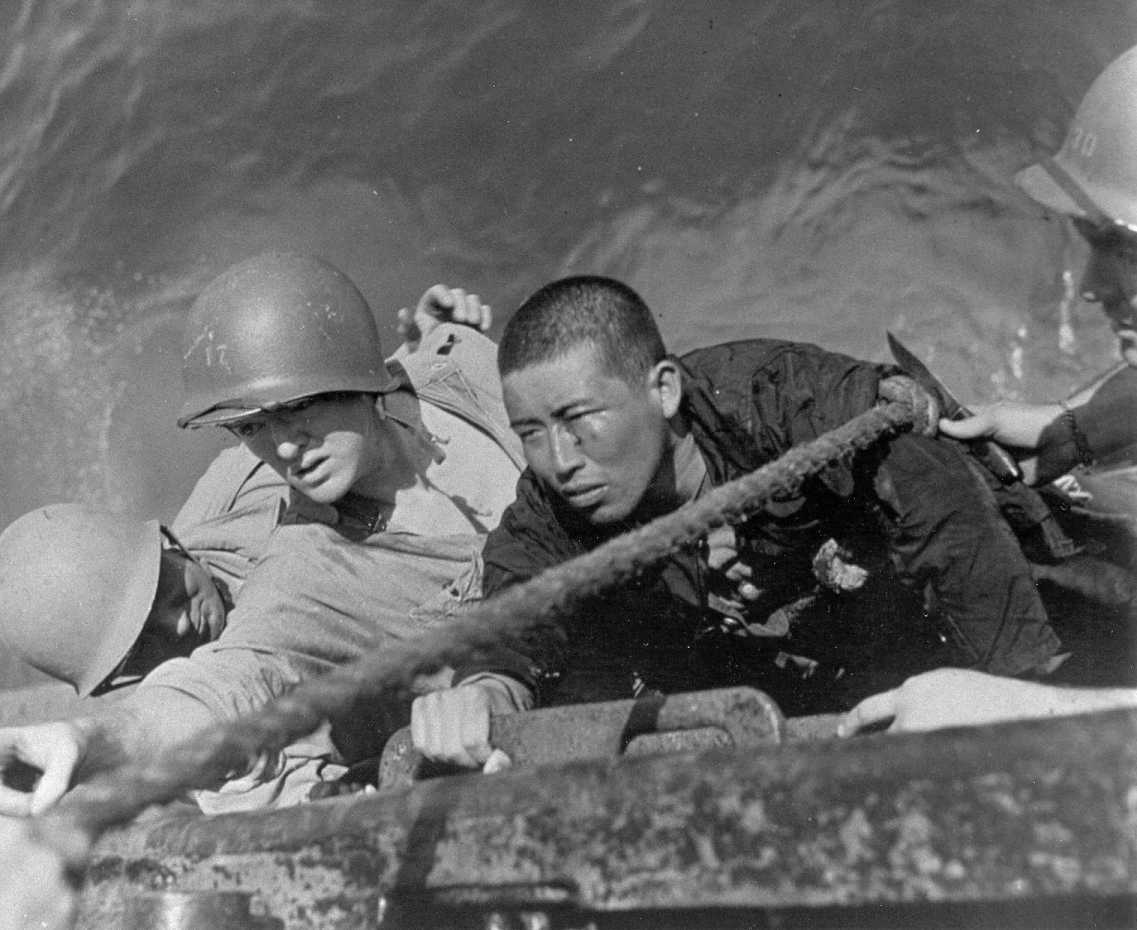
.
.
| Invasion Of Okinawa, Japan 25 March to 14 May 1945 |
 |
 |
| THE INVASION |
 |
| Arriving off southeastern Okinawa on the 25th, TEXAS began 7 days of pre-invasion bombardment. (For the next 52 days, almost every day involved gunfire support for the troops ashore and or firing at Japanese Kamikazes.) Part of the preliminary bombardment was in support of under-water-demolition work to clear obstructions from the landing beaches. |
| 29 March a Japanese aviator was seen in water 500 yards off the starboard bow. He was captured by the destroyer RODMAN and brought aboard TEXAS for initial identification and intelligence investigation. He was transferred to Carrier Task Force 51.15 later the same day. |
 |
| On 1 April, D-Day, TEXAS was off the southeastern Okinawa coast and firing
in the same area in a feint operation. As the Army and Marines pushed north and
south, TEXAS took up firing positions on the east and west coasts firing to the
north and south. An invasion was also made on the island of Ie Shima, off the northwest coast of Okinawa. TEXAS provided gunfire for under-water-demolition work on the 13th and 14th of April. TEXAS returned to Ie Shima on the 16th to provided gunfire support for the Army 77th Infantry Division going ashore. (It was on Ie Shima that war correspondent Ernie Pyle was killed, on 18 April). Her most intense broadside fired occurred on 8 May. In commemoration of "V-E" Day, all 10 14-inch guns and 3 5-inch guns were fired at one designated Japanese target. The gunfire at Okinawa was the most extensive of her history. She fired 2,019 14-inch shells and 2,640 5-inch shells. The expenditure of shells and powder required three replenishments at Kerama Retto, off the southwest tip of Okinawa. Note on 5" guns firing - only three 5-inch guns could fire at any one time compared to all 10 14-inch guns. To look at it another way, the 5-inch guns fired 30% more shells with only 30% of the gun barrels available to the 14-inch guns. (The 5-inch gun crews were busy!) |
| BB35 AIR OPERATIONS |
| #5-0-7 right Both OS2-U ("Kingfisher") airplanes made many flights over the island for photographic work and spotting. On 27 April, plane #5-0-8 made a forced landing near the ship after one such mission and sank from AA damage. The pilot and observer were rescued with the observer having a wound in his left from AA shell fragments. Also on 27 April, plane #5-0-7 strafed small boats near Nakagusuku Wan, eastern Okinawa. Earlier in the morning, suicide boats attempted an attack. |
 |
| JAPANESE AIR ATTACKS - 3 April to 28 April |
| Japanese air attacks were more numerous and intense then encountered at Iwo
Jima. On 3 April, she first fired her AA guns at a suspected JILL dead ahead but
no hits were observed. On the 7th she fired on a Kamikaze diving on the IDAHO,
but was shot down by IDAHO 50 yards off the IDAHO port beam (IDAHO was 800 yards
ahead of TEXAS). 12 April was the largest concentration of Kamikazes of the invasion. At 0416, a twin-engine BETTY crashed in flames 50 yards off TEXAS starboard quarter. (A delay of only 1-second in the firing of the AA guns would have enabled the plane to hit TEXAS). TEXAS and other ships of TF 54 fired AA guns until almost 2100. Suicide planes hit TF 54 ships TENNESSEE and ZELLARS. At 2047 a heavy underwater explosion was felt aboard TEXAS (The explosion was identified as a torpedo at the end of its run because a wake had been sighted aboard a nearby ship) During the Ie Shima landings of 16 April, BB35 shot down one Japanese plane making a suicide attack on BB35 and assisted in the down of three others.. The last air attack TEXAS fired in was 28 April. Additional air attacks occurred but none were in the TEXAS area. With so many ships in the same vicinity firing it was often impossible to determine which ship shot down which airplane. |
| DEPART FOR PHILIPPINES - 14 MAY |
| Though fighting on Okinawa does not cease until 22 June, TEXAS departs for
San Pedro Bay, Leyte Gulf, Philippines for preparation of the invasion of the Japanese home islands. |
.
Started 11 May 1999 Chuck Moore, FTV (1st Texas Volunteers) BB35 volunteer group